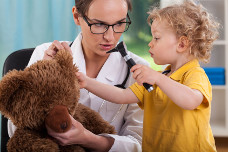Diagnostic procedures
Author: Gesche Tallen, MD, PhD, Editor: Dr. med. Gesche Tallen, Reviewer: Prof. Dr. med. Ursula Creutzig, English Translation: Hannah McRae, Last modification: 2024/02/27 https://dx.doi.org/10.1591/poh.kinderkrebsinfo.untersuchungen
If your child presents with symptoms indicative of cancer, or if cancer has already been diagnosed, different tests are necessary to confirm the diagnosis and to plan the required treatment.
- Once the diagnosis has been made, further tests (so called primary diagnostics or staging) are performed prior to treatment. They serve to determine whether the cancer has spread and what the patient's individual risk-factors are (risk-stratification) in order to plan optimal treatment. Risk-adapted treatment concepts contributed considerably to the dramatic increase in survival rates of childhood cancer patients during the last two decades.
- Further diagnostic exams follow during treatment in order to monitor the efficacy of the treatment and also to detect potential acute side-effects. Following the intensive treatment phase, follow-up exams are regularly performed to reveal longterm side-effects as well as recurrent disease.
The following pages will give you an overview of various diagnostic procedures that are commonly performed when a child has cancer. However, not every test is performed for every type of cancer. Certain diagnostics are reserved for specific diseases and individual situations, while others are routinely performed prior to, during or after treatment. Your child's caregiver-team will inform you on which tests are necessary for your child and why.
Detailed information on which tests are usually performed for a certain type of cancer is given on our pages referring to the different diseases.bb
References 
- Pizzo PA, Poplack DG (eds): Principles and Practise of Pediatric Oncology. Lippincott Williams & Wilkins Fifth edition 2006 [ISBN: 9780781754927]
- Gadner H, Gaedicke G, Niemeyer CH, Ritter J (Hrsg): Pädiatrische Hämatologie und Onkologie. Springer-Verlag 2006 [URI: http://www.springer.com/ medicine/ pediatrics/ book/ 978-3-540-03702-6]
- Gutjahr P: Krebs bei Kindern und Jugendlichen. Deutscher Ärzte-Verlag Köln 5. Aufl. 2004 [ISBN: 3769104285]
- Gutjahr P: Krebs? Mein Kind? Leukämie und bösartige Tumoren bei Kindern. S. Hirzel Verlag Stuttgart - Leipzig 2000, 53 [ISBN: 3-7776-0979-X]

